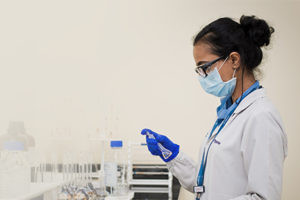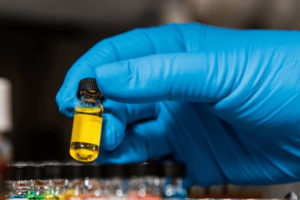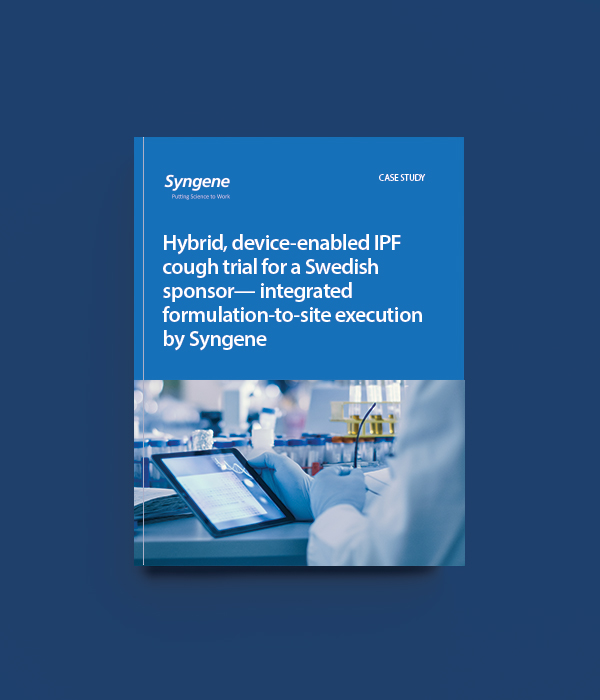At a glance
A clinical-stage biopharma, advanced IMP for chronic cough in idiopathic pulmonary fibrosis (IPF). The India, multicentre study used a hybrid model: objective 24-hour cough counts captured through VitaloJAK® alongside on-site clinical visits.
The primary endpoint was the 24-hour cough count integrated directly into the EDC. Syngene delivered end-to-end support — placebo and IMP manufacture/encapsulation, blinding and labelling/packaging, IRT/EDC orchestration, central lab and bioanalytical, regulatory submissions, site start-up and monitoring, data management, biostats/programming, and final CSR.
Introduction
IPF patients live with a persistent, energy-sapping cough that conventional antitussives rarely address. The Sponsor is developing, an oral candidate to reduce cough counts in these patients. For its first India programme, the sponsor needed a partner who could connect “capsule to clinic” and run a device-anchored primary endpoint without drama. Syngene stepped in with an integrated, single-operator model to keep execution tight and timelines honest.
Client’s challenge
This was the sponsor’s first study in India, so regulatory pathways, vendor management, and site networks all needed clear navigation. The supply strategy had to preserve blinding rigor: manufacture of matching placebo and encapsulation of IMP to ensure visual parity, with clean randomisation and compliant labels tied to IRT codes. The primary endpoint was device-based— 24-hour cough counts — which had to be recorded consistently across sites and imported into the EDC error-free. Timelines were tight, and there were real-world delays on DCGI approvals. The sponsor also wanted one accountable partner to carry the chain end-to-end, from formulation and packaging through central lab, start-up, monitoring, data cleaning, statistics/programming, and CSR delivery.
Why Syngene
Syngene offered a genuinely single-operator chain. Formulation and clinical operations ran under one roof, with pre-aligned playbooks for Clinion (EDC/IRT) and Bilcare (packaging/labelling). The central lab and bioanalytical functions sat alongside data management and programming, which meant fewer hand-offs, faster issue resolution, and much less friction at the interfaces. In plain speak: one team, one plan, no ping-pong.
Solution & delivery model
Supply, blinding, and code integrity
We manufactured placebo and encapsulated IMP to maintain indistinguishability, then packaged and labelled exactly as per the randomisation schedule. Reconciliation controls were built into both the IRT and warehouse SOPs. Blinding integrity was monitored centrally, with predened unblinding contingencies sitting quietly in the background (never needed). The result was a neat supply chain with zero loose ends.
Device data pipeline (VitaloJAK® EDC)
We standardised 24-hour cough recording at sites using crisp job aids and ran a first-patient-first-visit dry-run to iron out device handling quirks. A secure import pathway moved vendor output into Clinion EDC system with eld-level edit checks, audit trails, and automated receipts. Across 51 patients, the device dataset landed without a single import error and was independently confirmed by the global device vendor.
Hybrid operations and patient experience
We combined on-site assessments with decentralised, at-home 24-hour cough recordings to reduce patient burden while staying protocol-true. Patients received simple, visual instructions and a helpline for device queries. The data centre ran “call-back if odd values” triggers to catch anomalies early. The hybrid design helped keep IPF patients comfortable without compromising endpoint quality.
Regulatory pathing and risk controls
When DCGI approvals moved slower than expected, we activated contingency site plans and a rolling start-up sequence to protect recruitment pace. The medical monitor conducted an extra risk-assessment visit; no safety issues emerged. QA audited a top-recruiting site and confirmed patient safety and data integrity, with only minor notes and no material CAPAs.
Data management, stats, and lock discipline
Data cleaning ran in real time around cough counts, clinical forms, and sites received daily exception dashboards. Even after enrolling roughly 25% more patients than originally planned to strengthen robustness, the database locked on the original timeline. Programming shells were prepared early so listings and tables didn’t jam up the tail. The CSR was authored to spec, with the device primary endpoint owing through cleanly.
What changed
Recruitment finished on time even with the enrolment uplift. Endpoint integrity held — cough data from all 51 patients flowed into the EDC without import errors. Blinding stayed intact from kit to subject to reconciliation. The database locked as scheduled despite expanded enrolment; there were no last-minute firefights. QA and medical monitoring confirmed that patient safety was never compromised. Internally, this became Syngene’s first integrated project that truly bridged formulation development with clinical trial management, and our first hybrid trial in India with a device-captured primary endpoint.
Business impact for the sponsor
The sponsor now has an operational proof-point in India for running a device-anchored primary endpoint at scale. That de-risks future multi-country designs and gives a cleaner story for boards and investors: recruitment discipline, endpoint reliability, and on-time database lock. With a complete CSR and tidy audit trail, the programme moves into its next decision gate with confidence. As the sponsor’s medical lead put it, “This is great confirmation of your and the Syngene team’s work. We can be reassured that the subjects received the assigned treatment as per the protocol. It is a successful study with great execution from the team on the ground – regardless of the results.”
Methodology snapshot
Governance ran through an integrated PMO with weekly cross-functional huddles that included vendors, backed by exception-based escalations. Clinion handled EDC/IRT, Bilcare handled packaging and labels, and the global device vendor provided cough data outputs, while Syngene’s central lab and bioanalytical teams ensured uniform methods and turnaround. Controls included pre-dened device-handling SOPs, double-checks at import, and targeted SDV on cough-critical elds. Documentation was kept ahead of the curve — edit-check specs were locked early, TLF shells were prepared in advance, and CSR authoring milestones were baked into the start-up plan.







